Molesworth
Are You Related to the McCormacks?
08 11 23 14:24 Filed in: Jim
Over the years Sue and I have been writing our family stories, we have developed our own little tradition of excursions. We spent a day at Croydon visiting our mother’s childhood haunts; we parked outside our own childhood home and retraced our walk to school; and we spent a day driving between the Pakenham Bourke’s properties.
Now, after months of piecing together the McCormack and Hamilton backgrounds, marvelling at the story of three McCormack boys marrying three Hamilton girls, we were going to visit the actual sites. Very conveniently, we could stay at Sue and Jono’s property nearby. We roughed out an itinerary, and a food and wine list. The forecast was dubious, but we would mostly be in the car. Jono offered himself as designated driver.
On the first morning, we pulled into Molesworth, familiar as the second last town before Sue and Jono’s road. I looked at the hall, right on the main road. We took pictures, and peered in the dirty windows.
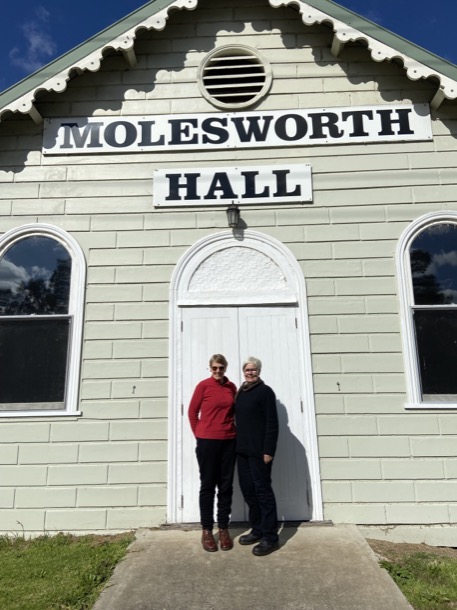
It wasn’t until I walked down the side of the building that the significance of it all hit me. There, on a hill behind the town strip, sat Balham Hill, the red brick house our grandmother grew up in. Her father had donated the land for the hall. We noted that the hill was much too steep for young ladies to navigate.
The right turn into Whanregarwen Road was very near. We parked in the clearing next to the Rail Trail, and Sue and I climbed a rough cutting until we could see Balham Hill again, in its home paddock.
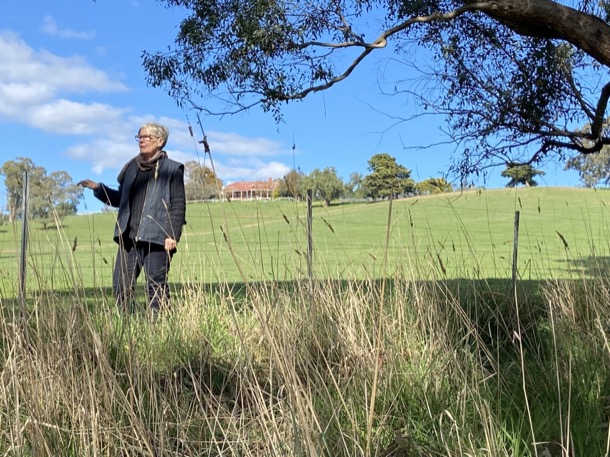
We turned to look out across the river to the hills beyond. What a view they had had. Not even the great 1870 flood would have reached the house perched right up there. And how close to the homestead the train line had been! The twice daily trains would have made their presence felt.
I thought about Grace, our grandmother growing up here, in this grand house, going to primary school in Molesworth, a short walk away. Her father, John, was an important man in the district, a Justice of the Peace and on the Yea council. When Grace was seven, the house had been extended and rebuilt.
A little further on we came across Balham Hill’s proper driveway, and a different view of the house. With her knowledgable eye, Sue noted the quality of the the land itself, and of the farming techniques, where many trees were left in the pastures.
With an eye on Google Maps, we drove on. The property up the road a bit had belonged to the previous generation: our great, great grandparents, James and Bridget Hamilton. We knew that they had selected the property, “Cremona” estate, 1220 acres, in 1866. It was “situated on the southern concave side of a great sweeping arc of the Goulburn River … rising to high ground in the south where it fronts the Whanregarwen Road.”
The "great sweeping arc” is still there, in spite of 150 years of floods and droughts. It means that the river leaves Whanregarwen Road at right angles. We stopped at that spot, looking out over the river flats. “This would have been Cremona land”, said Sue.
A farm bike pulled up alongside us. We can’t remember exactly what the man said, but it was something like “Can I help you?” but tinged with suspicion. As we wound down our windows, I thought of Chris’s quip about being ready to bail us out when we were picked up for loitering
After some explanations, Jono mentioned his and Sue’s nearby property on the Gobur Road, and it emerged that this young man, Matt Ridd, owned the business, Murrindindi Kitchens, who had put in their kitchen. The atmosphere warmed immediately, and Matt told us what he remembered of the old house at Cremona. His family, too, went back many generations in that area.
He was full of stories. The old house was gone before he was born, but he used to play around there, by the area known as the “old Cremona Drive”, where there were old bricks and things. There was an old brick lined well, down near the river, full of snakes. There had been a communal sheep wash at Balham Hill. We drank it all in eagerly.
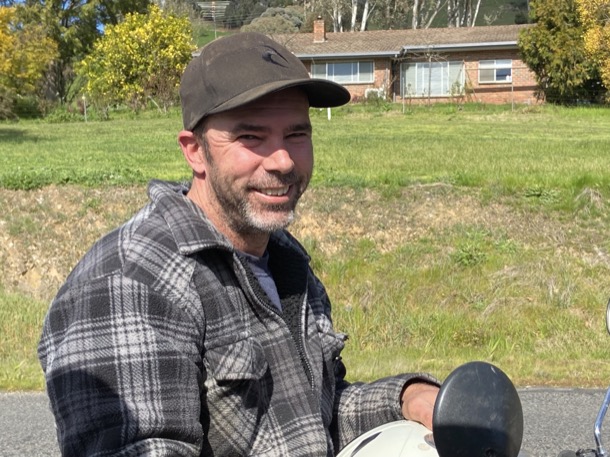
Eventually he turned his bike around and led us up the road, around the corner to an unmarked farm gate. We took photos, and pointed to twin lines of deciduous trees that could well have flanked Cremona’s driveway.
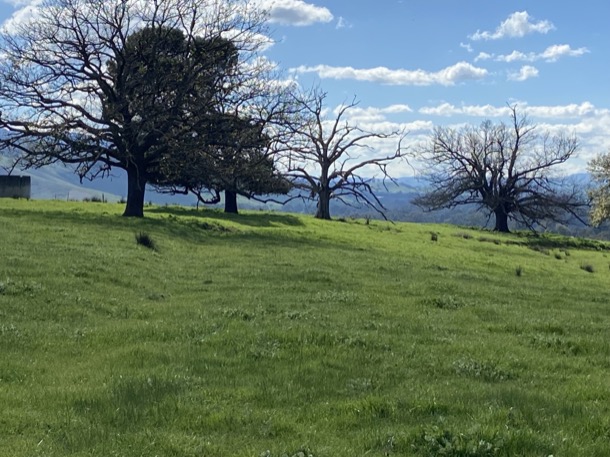
Off in the distance the river seemed a long way down. We had read the story of the 1870 flood surrounding and isolating the original house, and of James rescuing the family in the middle of the night, by crossing a flooded creek with horse and dray. Afterwards he rebuilt the house on much higher ground. Matt left us and we drove off in the other direction towards Alexandra.
As we drove, I pictured James driving his family to Sunday Mass along this road. The story goes that he would hurry up his daughters, complaining that his “Presbyterian horses couldn’t wait all day for lazy Catholics.”
The winding road down the hill into Alexandra from Cremona, is a familiar route for Jono and me. As we arrived in Alexandra, we were looking at the town with different eyes. We passed the impressive Shire Hall and Library and wondered whether any of the Hamiltons had graced the steps of either building. Charles Hamilton, James’s only son, and heir to Cremona was Shire president three times, so he may have even been involved in their creation.
The people with the answers are now in Alexandra Cemetery, our next destination.
We easily found the Catholic section with its assortment of Celtic Crosses, the tallest belonging to Charles’s wife Hannah, who died quite young, leaving two young children and a baby.
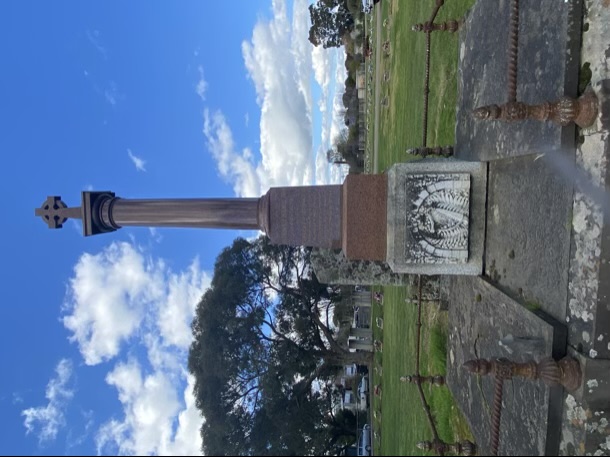
We did not find Charles or his parents in this section, so we decided to have Margaret’s salad rolls and a cup of tea in the sun and continue the search after lunch.
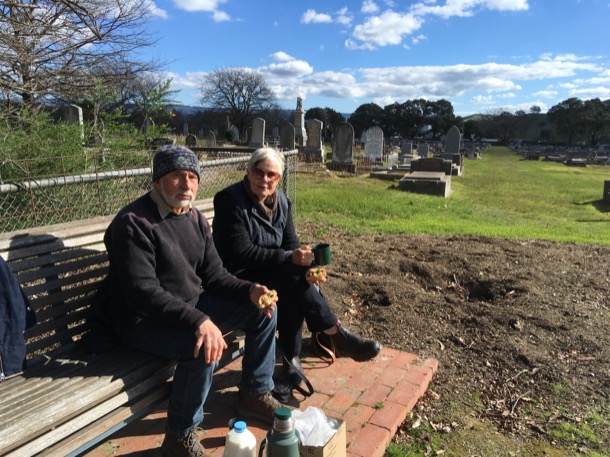
In the Protestant section, we did find more Hamiltons. Agnes, James’s mother, who emigrated with him, and James himself is also on the headstone. You may remember from our previous post, that they were both Protestants. Very fitting and buried in the correct section. Buried with them, is Brigid, who chose not to be buried in the Catholic section but here with her husband and mother in law. Their daughter Sara, who died at twenty-three, is also buried here. We did not find Charles although we do know he is buried at Alexandra too. Our excuse is that this was our first graveyard and we were not yet expert headstone hunters. I will return on my next trip into Alex with my new found expertise.
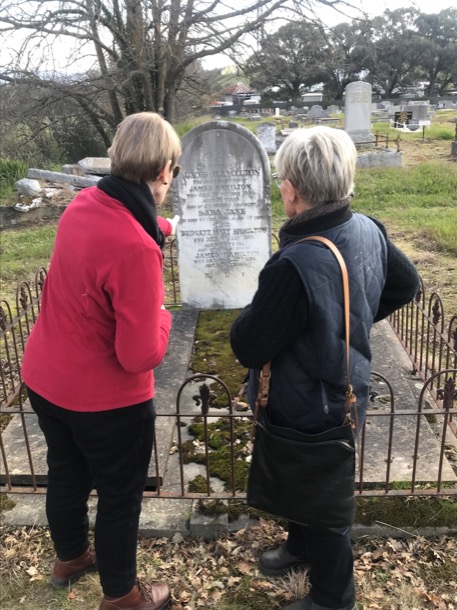
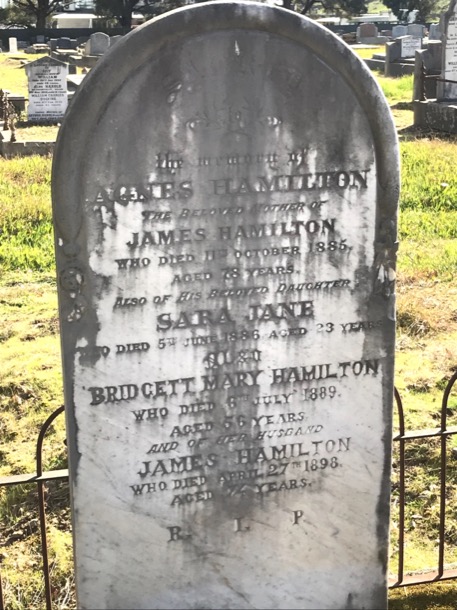
That night, in front of the fire at Sue and Jono’s house, as Jono cooked our Spanikopita dinner, Sue and I poured over our notes. I opened up and reread the 2006 article we had found in the journal “Eureka Street”, where Peter Hamilton, great grandson of the original Hamiltons of Cremona, describes his own visit to Alexandra cemetery, and the site of Cremona. Right there, in the article, was the name Les Ridd.
Matt Ridd, perched on his motorbike on the side of Whanregarwen Road, had described his dad’s recent illness, and here was a story about him taking Peter around Cremona in 2005.
Matt had given Sue his mobile number, and she texted him the link. Matt immediately rang back. Sue and Matt shared more stories. It was exciting to find that real world link with our past.
Later, on the strength of our interaction with Matt, I reached out to Peter Hamilton, author of the article. More about that in a later post.
The next morning, our first destination was Landscape at Tallarook. As we drove via Yea on the same route the young Hamilton girls would have taken, we again wondered how the three young ladies travelled to the Tallarook railhead and how long it took them. It took us fifty minutes on a good bitumen road.
Originally John McCormack Snr, of Red Barn, had bought the property, then called Tallarook House. Some of his sons had lived there, and, eventually one of them, James, became its long term owner.
After they were married, James and Grace changed the name of the property from Tallarook House to ‘Landscape.’ Archbishop Little in his small family history waxes lyrical about the property and the life there.
…….’Landscape’ a more fitting name for the unique and pleasant vistas of scenery viewed from its open wide verandahs.
After settling in at “Landscape”, husband and wife took a prominent part in the social, civic, charitable ,religious, and sporting life of the community and continued to do so throughout their lives. Landscape with its gracious hostess was a perfect setting…….
It is still is a beautiful, prime pastoral property. When it sold most recently in 2017, as a much reduced holding, it still boasted three kilometres of Goulburn River frontage.
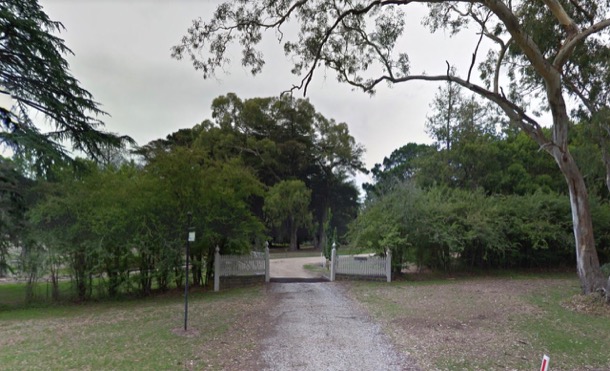
Landscape today still looks very much the gracious country house. It still sits amidst a cluster of small houses and large stone stables. The lovely old house overlooks the Goulburn and is set in a large well tended garden dominated by old stately trees. We wondered if James and Grace had planted the trees.
We wanted to stop and have a really good look, but the security cameras and the gentleman trimming the hedge were a little off putting. We settled for another drive past. On one side of the house Landscape now has its own vineyard, a more recent addition we think. Not so Tennis Court Paddock, on the other side of the house. No longer a tennis court, but we could imagine in days past it would have been a well used addition.
It was a short drive from Landscape to Tallarook. The old railway line, now a rail trail, had followed the road. It culminated in the Tallarook Railway Station, which is still in operation, on the main Melbourne to Sydney line. Back when James McCormack was establishing himself in the district, it was the railhead. Although much reduced in capacity and importance, it still has the feeling of a substantial, permanent structure. What had been high wide doors have been bricked in. There are a few historical signs, but it was hard to get a sense of the bustling, smelly, noisy place it once would have been. We took photos and moved on.
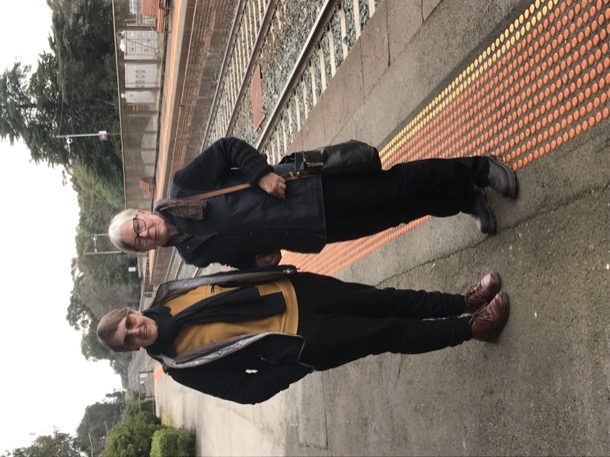
We drove into the grassy grounds of St Joseph’s. There is very little information about this church. It was blessed in July 3rd 1887 by Archbishop Carr.
It is sad to realise that this beautiful bluestone building is now virtually unused. It is not listed on the Diocese website.
Jono had sent an email to the Seymour parish priest the day before, in the hope that we might get a peek inside, but there was no reply.
The slate roof looked sound, and all the windows were intact, thanks to heavy wire screens on the outside of them. Archbishop Little tells us that “The memory of Grace and James McCormack has been retained in the Catholic community of Tallarook by the erection in St. Joseph's Church of ornate stained glass windows…”
We couldn’t really see the windows very well from the outside, but they looked substantial.
The only other buildings on the block were two little ramshackle outdoor dunnies, tucked under the trees on the outskirts of the cleared area.”
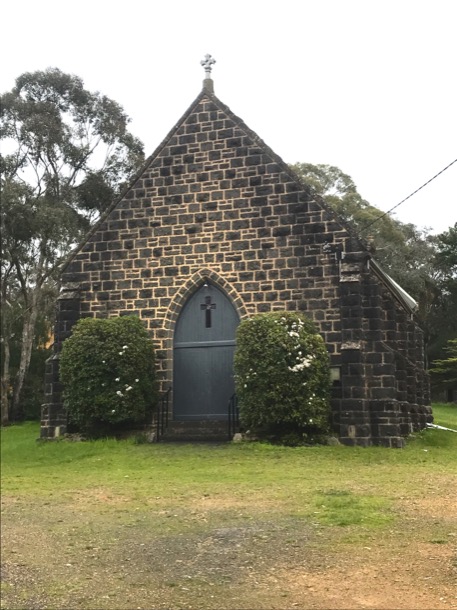
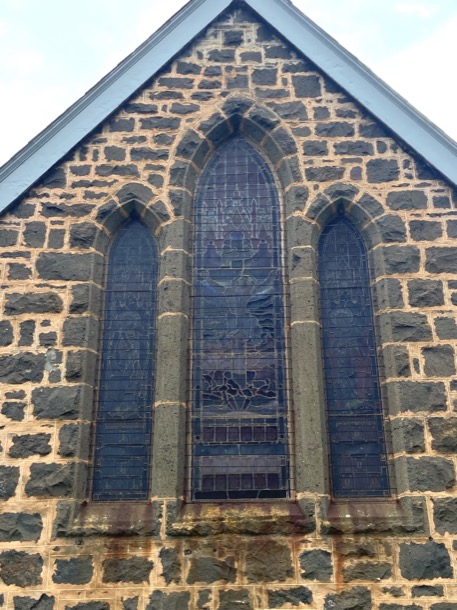
James and Grace had been dominating our thoughts in Tallarook, and now we drove on the the Seymour cemetery to find their graves.
Far from finding a quiet country cemetery, we found ourselves over the road from the busy midweek races at the Seymour Racetrack. Dodging horse floats, we turned right and parked in the cemetery grounds. We huddled quietly by the car, hoping that we weren’t intruding on a funeral still in progress. The land around Seymour is dry and stony, and heavy grey skies reminded us that rain had been forecast.
The sections in the cemetery were clearly labelled, and we headed toward the forest of Celtic Crosses in the Catholic section.
There were McCormacks everywhere. But the largest marble Celtic cross marked the graves of Grace, aged 56 and James JP (Justin of the Peace), aged 78.
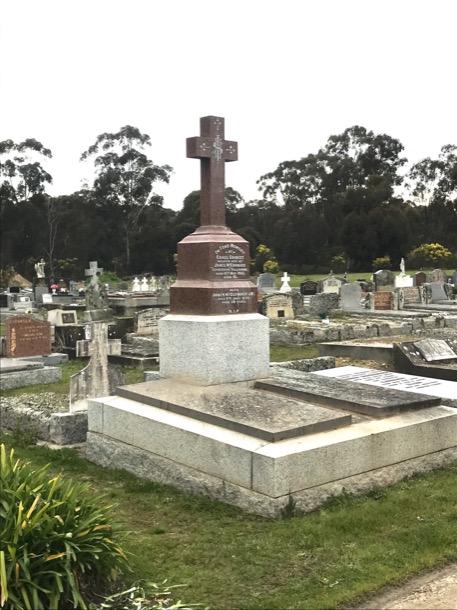
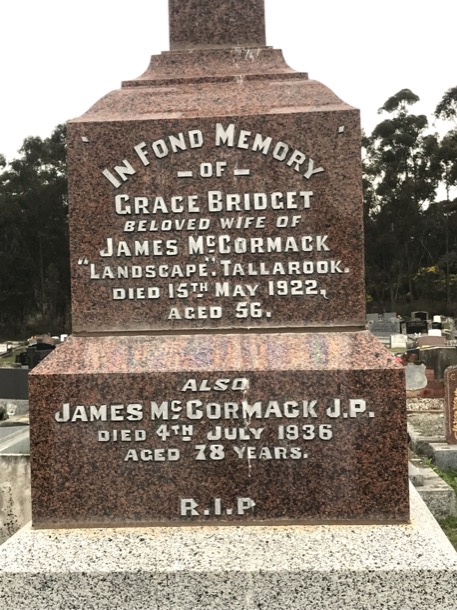
We drove through Seymour. I tried to see it as it had been when James was president of the Council, but the church has been rebuilt, the town has grown, and the sad, unkempt, crowded together little houses and struggling small businesses overpower any sense of history.
Rain was still threatening, and the wind was cold, as we pulled up at the Tourist Park alongside the river in Euroa. Parked a few cars away, was Janet, who Sue and Jono knew from Trust for Nature. Janet is a local landowner, active in all local environmental organisations and activities. She was cleaning up, after running a morning water-quality training session in the river.
When we explained our mission, she exclaimed, in her larger-than-life voice,
“Oh! Are you related to the McCormacks?”
“Yes, our grandmother was a McCormack.”
It felt real. We did belong to these people: men who had dominated four local councils and been part of all the important local infrastructure decisions for the second half of the nineteenth century, and the beginning of the twentieth. Families whose weddings were written up in the local papers, whose names were on the stained glass windows in the churches, whose memorials dominated the cemeteries.
We ate our egg sandwiches and drank tea from the thermos huddled in a shelter by the river. Euroa felt older, more solid and prosperous than Seymour.
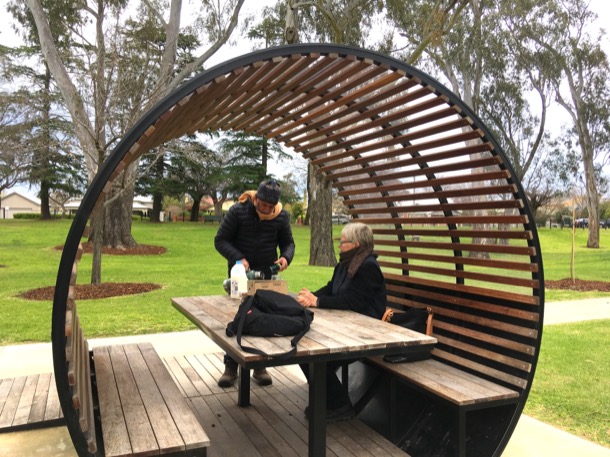
The Euroa McCormack was Thomas, the eldest of John and Jane’s children, born at Red Barn in Beveridge. We hadn’t spent much time exploring Thomas’s story, because we had been so taken by the romance of his younger brothers, James, John and Michael who had married the three Hamilton sisters. But here, in Euroa, it felt important to fit him into the story.
We had a few notes, (and a bit of subsequent expert input, to be explained later) and spent a bit of time pulling his story together.
Thomas was the eldest son of John and Jane McCormack of Red Barn Beveridge. He was born in 1851.
After living with his brothers James and Michael at Landscape, Thomas purchased a property in Mooroopna, near Shepparton, in 1882.
The property was called “The Desert”, and was in Toolamba Road. Like the other family properties, Thomas’s was along the Goulburn River, but much further north.
Soon after moving to Mooroopna, Thomas married Bridget Agnes Cooke, of Pyalong. There’s more to find our about this, but we think that Bridget’s brother John might have also invested in this property. Over time, it seems that the property developed into a “fine property” called May Park Estate.
Thomas and Bridget were active community members. In particular, Thomas was very involved with the Mooroopna Hospital Board. They had four sons and two daughters.
In 1908, Thomas and Bridget sold up in Mooroopna and bought “Springside” in Gooram, near Euroa. Thomas was 57, and Bridget, 55. It seems they immediately became involved in their new community.
In 1912, Bridget became sick with colon cancer. After a difficult two years, she died. She was 61.
Thomas remarried two years later, in 1916. We don’t know much about his second wife, Elizabeth. She was the daughter of Patrick and Elizabeth O’Connor of “Parkview”, Kilmore.
Then, in 1918, further tragedy struck. Daughter Mary, who lived with Thomas and Elizabeth at Gooram, died, aged thirty.
We can only speculate about Thomas’s motives, but, quite soon, he sold up and they moved into town. His new house was “Marengo” in Anderson St.
Thomas and Elizabeth had thirteen years together. It seems they built a busy, community-focussed life in Euroa. Among other things, Thomas was involved in the District Racing Club, the Agricultural Society, the Band, the Swimming Club and the Bush Nursing Hospital.
Thomas died in 1929, aged 78.
Elizabeth, who is buried alongside him in Euroa, lived in Hawthorn for a further fourteen years. She died in 1943.
Euroa Cemetery, like Seymour Cemetery, is in a rather uninspiring location. Separated from the town by the Hume Freeway, it sits amongst flat empty paddocks.
It was still cold and raining a little, as we approached the rows of graves, looking for the Catholic section and the telltale sign of the Celtic Crosses. Well practised now, we headed for the tallest cross.
Sure enough, we found the McCormack’s lichen encrusted, but still readable, very large granite Celtic Cross. Buried here are Thomas McCormack and Brigid, his first wife, and mother of his children, who died fourteen years before him. Only four years later, Mary their daughter also died, and is buried with her parents. Many years later, in 1943, Elizabeth, Thomas’s second wife, was also interred in this plot. She had lived in Hawthorn after Thomas’s death, but chose to be buried here with him.
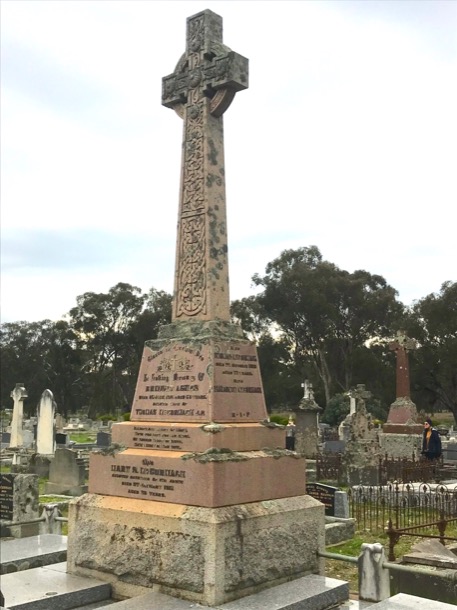
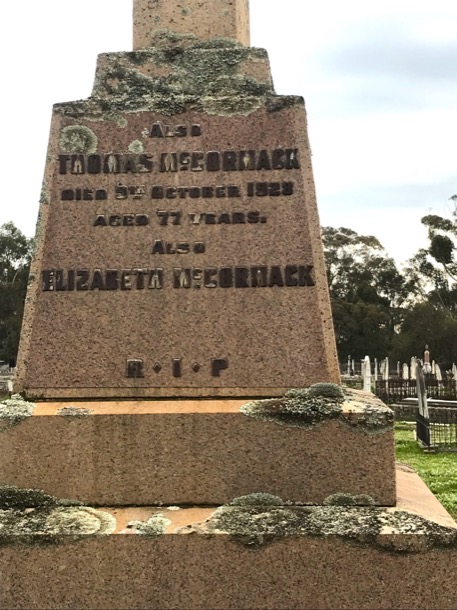
We were also fascinated to see, crowded in next to the McCormack plot, the priests and nuns of Euroa. Notably, the nuns' graves were a little smaller.
Having found Thomas’s grave we set off to find his property, Springside, at Gooram.
We drove into the Strathbogie Ranges on the beautiful Euroa-Merton Road for seventeen kilometres, and then turned right, onto a long straight road that followed the valley.
It was a lovely tree-lined road with only one or two properties along it. It seemed very remote to us. What must it have been like when Thomas and Brigid lived here?
The first indication that we were there, was a large new sign, ‘Springside’ at the beginning of a long drive that disappeared over the hill.
Of great interest though was the very large Banksia marginata on the road verge, right opposite the gate. There are very few original Banksia marginata left in the Strathbogie Ranges, and we had never seen such a large one. We wondered how old it was and if it had been growing there, as Thomas and family drove and rode past.
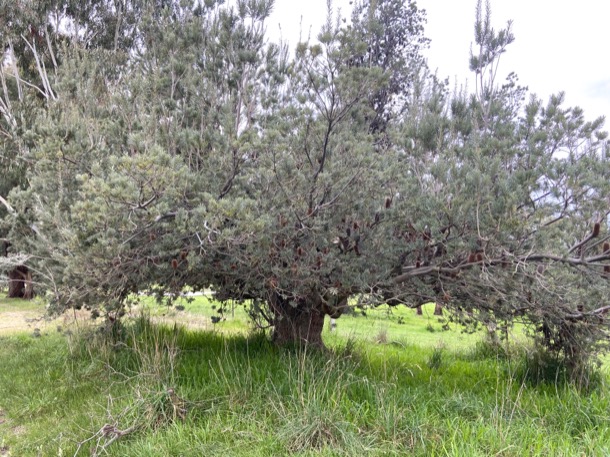
As no house was obvious here, we drove on. Almost at the end of the road, there was the house, sitting quietly in its old garden. It is not as grand a house as Landscape, but it looks substantial and comfortable. Thomas’s white, weatherboard house is surrounded on three sides by a wide verandah and we could imagine Thomas sitting on the verandah, looking across the lush paddocks to the distant hills, fires roaring in the fireplaces inside. It was certainly a lovely spot.
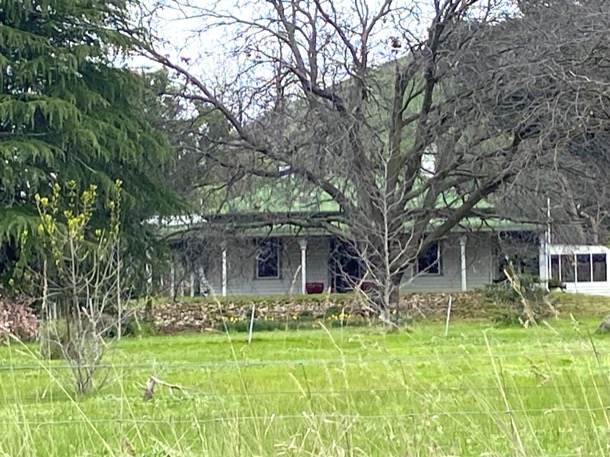
Our last day of graveyard hopping dawned cold and wet again. Very appropriate and atmospheric weather, and Yea Cemetery did not disappoint.
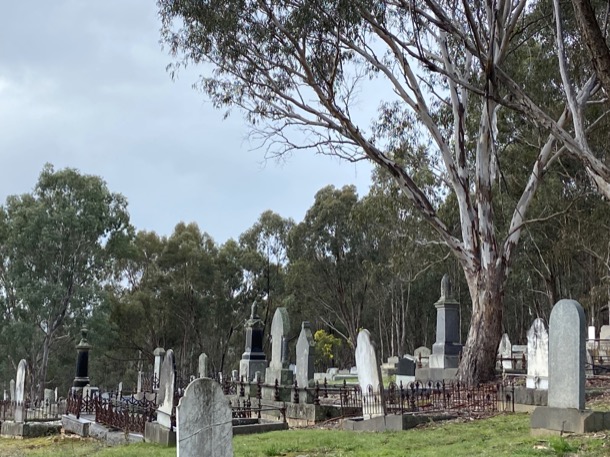
The old cemetery, surrounded by bushland, was tucked away on the hill, behind Yea township. The newer section of the cemetery, lies bland, uninteresting and uninspiring, out of sight.
Unlike all the other cemeteries that have been in flat and open expanses, Yea is set in a hilly spot. We arrived and walked up the small, treed hill, looking once again for the Catholic section. Not as many Celtic Crosses to guide us here and no clear signage. Near the top of the hill we began to see the Irish surnames, so the hunt for our great grandparents began in earnest. It was raining more heavily now, and we thought we were to be disappointed, but Jono saved the day.
Not a Celtic Cross, but a large impressive slab, with all that we sought buried here. It was sobering to think that our grandmother, Grace had stood here, as the bodies of John and Joan (previously called Johanna) McCormack, her parents, were interred. Maybe our father as a four year old child had been there too.
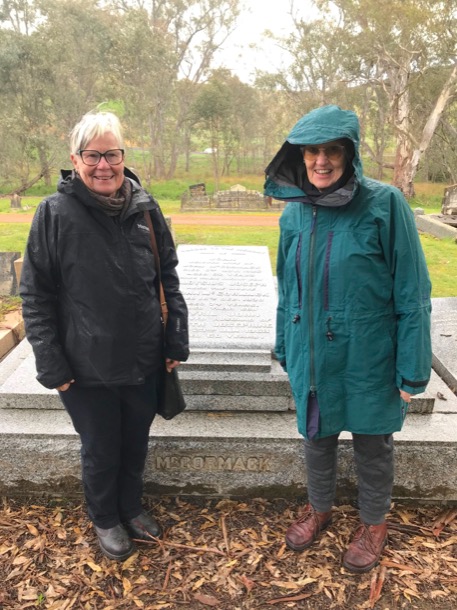
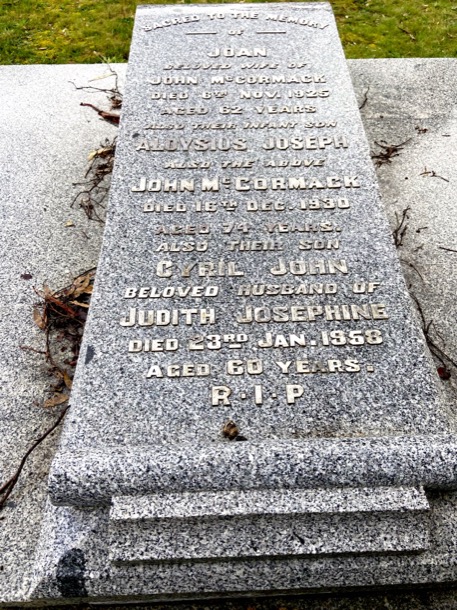
Also on the stone were John’s and Joan’s infant son Aloysius who died aged ten months and Cyril, Grace’s brother and his wife Judith. Quite a family plot.
What a beautiful little cemetery in which to end our journey around Central Victoria and how fitting to end it with the resting place of our great grandparents.
Now, after months of piecing together the McCormack and Hamilton backgrounds, marvelling at the story of three McCormack boys marrying three Hamilton girls, we were going to visit the actual sites. Very conveniently, we could stay at Sue and Jono’s property nearby. We roughed out an itinerary, and a food and wine list. The forecast was dubious, but we would mostly be in the car. Jono offered himself as designated driver.
On the first morning, we pulled into Molesworth, familiar as the second last town before Sue and Jono’s road. I looked at the hall, right on the main road. We took pictures, and peered in the dirty windows.

It wasn’t until I walked down the side of the building that the significance of it all hit me. There, on a hill behind the town strip, sat Balham Hill, the red brick house our grandmother grew up in. Her father had donated the land for the hall. We noted that the hill was much too steep for young ladies to navigate.
The right turn into Whanregarwen Road was very near. We parked in the clearing next to the Rail Trail, and Sue and I climbed a rough cutting until we could see Balham Hill again, in its home paddock.

We turned to look out across the river to the hills beyond. What a view they had had. Not even the great 1870 flood would have reached the house perched right up there. And how close to the homestead the train line had been! The twice daily trains would have made their presence felt.
I thought about Grace, our grandmother growing up here, in this grand house, going to primary school in Molesworth, a short walk away. Her father, John, was an important man in the district, a Justice of the Peace and on the Yea council. When Grace was seven, the house had been extended and rebuilt.
A little further on we came across Balham Hill’s proper driveway, and a different view of the house. With her knowledgable eye, Sue noted the quality of the the land itself, and of the farming techniques, where many trees were left in the pastures.
With an eye on Google Maps, we drove on. The property up the road a bit had belonged to the previous generation: our great, great grandparents, James and Bridget Hamilton. We knew that they had selected the property, “Cremona” estate, 1220 acres, in 1866. It was “situated on the southern concave side of a great sweeping arc of the Goulburn River … rising to high ground in the south where it fronts the Whanregarwen Road.”
The "great sweeping arc” is still there, in spite of 150 years of floods and droughts. It means that the river leaves Whanregarwen Road at right angles. We stopped at that spot, looking out over the river flats. “This would have been Cremona land”, said Sue.
A farm bike pulled up alongside us. We can’t remember exactly what the man said, but it was something like “Can I help you?” but tinged with suspicion. As we wound down our windows, I thought of Chris’s quip about being ready to bail us out when we were picked up for loitering
After some explanations, Jono mentioned his and Sue’s nearby property on the Gobur Road, and it emerged that this young man, Matt Ridd, owned the business, Murrindindi Kitchens, who had put in their kitchen. The atmosphere warmed immediately, and Matt told us what he remembered of the old house at Cremona. His family, too, went back many generations in that area.
He was full of stories. The old house was gone before he was born, but he used to play around there, by the area known as the “old Cremona Drive”, where there were old bricks and things. There was an old brick lined well, down near the river, full of snakes. There had been a communal sheep wash at Balham Hill. We drank it all in eagerly.

Eventually he turned his bike around and led us up the road, around the corner to an unmarked farm gate. We took photos, and pointed to twin lines of deciduous trees that could well have flanked Cremona’s driveway.

Off in the distance the river seemed a long way down. We had read the story of the 1870 flood surrounding and isolating the original house, and of James rescuing the family in the middle of the night, by crossing a flooded creek with horse and dray. Afterwards he rebuilt the house on much higher ground. Matt left us and we drove off in the other direction towards Alexandra.
As we drove, I pictured James driving his family to Sunday Mass along this road. The story goes that he would hurry up his daughters, complaining that his “Presbyterian horses couldn’t wait all day for lazy Catholics.”
The winding road down the hill into Alexandra from Cremona, is a familiar route for Jono and me. As we arrived in Alexandra, we were looking at the town with different eyes. We passed the impressive Shire Hall and Library and wondered whether any of the Hamiltons had graced the steps of either building. Charles Hamilton, James’s only son, and heir to Cremona was Shire president three times, so he may have even been involved in their creation.
The people with the answers are now in Alexandra Cemetery, our next destination.
We easily found the Catholic section with its assortment of Celtic Crosses, the tallest belonging to Charles’s wife Hannah, who died quite young, leaving two young children and a baby.

We did not find Charles or his parents in this section, so we decided to have Margaret’s salad rolls and a cup of tea in the sun and continue the search after lunch.

In the Protestant section, we did find more Hamiltons. Agnes, James’s mother, who emigrated with him, and James himself is also on the headstone. You may remember from our previous post, that they were both Protestants. Very fitting and buried in the correct section. Buried with them, is Brigid, who chose not to be buried in the Catholic section but here with her husband and mother in law. Their daughter Sara, who died at twenty-three, is also buried here. We did not find Charles although we do know he is buried at Alexandra too. Our excuse is that this was our first graveyard and we were not yet expert headstone hunters. I will return on my next trip into Alex with my new found expertise.


That night, in front of the fire at Sue and Jono’s house, as Jono cooked our Spanikopita dinner, Sue and I poured over our notes. I opened up and reread the 2006 article we had found in the journal “Eureka Street”, where Peter Hamilton, great grandson of the original Hamiltons of Cremona, describes his own visit to Alexandra cemetery, and the site of Cremona. Right there, in the article, was the name Les Ridd.
Matt Ridd, perched on his motorbike on the side of Whanregarwen Road, had described his dad’s recent illness, and here was a story about him taking Peter around Cremona in 2005.
Matt had given Sue his mobile number, and she texted him the link. Matt immediately rang back. Sue and Matt shared more stories. It was exciting to find that real world link with our past.
Later, on the strength of our interaction with Matt, I reached out to Peter Hamilton, author of the article. More about that in a later post.
The next morning, our first destination was Landscape at Tallarook. As we drove via Yea on the same route the young Hamilton girls would have taken, we again wondered how the three young ladies travelled to the Tallarook railhead and how long it took them. It took us fifty minutes on a good bitumen road.
Originally John McCormack Snr, of Red Barn, had bought the property, then called Tallarook House. Some of his sons had lived there, and, eventually one of them, James, became its long term owner.
After they were married, James and Grace changed the name of the property from Tallarook House to ‘Landscape.’ Archbishop Little in his small family history waxes lyrical about the property and the life there.
…….’Landscape’ a more fitting name for the unique and pleasant vistas of scenery viewed from its open wide verandahs.
After settling in at “Landscape”, husband and wife took a prominent part in the social, civic, charitable ,religious, and sporting life of the community and continued to do so throughout their lives. Landscape with its gracious hostess was a perfect setting…….
It is still is a beautiful, prime pastoral property. When it sold most recently in 2017, as a much reduced holding, it still boasted three kilometres of Goulburn River frontage.

Landscape today still looks very much the gracious country house. It still sits amidst a cluster of small houses and large stone stables. The lovely old house overlooks the Goulburn and is set in a large well tended garden dominated by old stately trees. We wondered if James and Grace had planted the trees.
We wanted to stop and have a really good look, but the security cameras and the gentleman trimming the hedge were a little off putting. We settled for another drive past. On one side of the house Landscape now has its own vineyard, a more recent addition we think. Not so Tennis Court Paddock, on the other side of the house. No longer a tennis court, but we could imagine in days past it would have been a well used addition.
It was a short drive from Landscape to Tallarook. The old railway line, now a rail trail, had followed the road. It culminated in the Tallarook Railway Station, which is still in operation, on the main Melbourne to Sydney line. Back when James McCormack was establishing himself in the district, it was the railhead. Although much reduced in capacity and importance, it still has the feeling of a substantial, permanent structure. What had been high wide doors have been bricked in. There are a few historical signs, but it was hard to get a sense of the bustling, smelly, noisy place it once would have been. We took photos and moved on.

We drove into the grassy grounds of St Joseph’s. There is very little information about this church. It was blessed in July 3rd 1887 by Archbishop Carr.
It is sad to realise that this beautiful bluestone building is now virtually unused. It is not listed on the Diocese website.
Jono had sent an email to the Seymour parish priest the day before, in the hope that we might get a peek inside, but there was no reply.
The slate roof looked sound, and all the windows were intact, thanks to heavy wire screens on the outside of them. Archbishop Little tells us that “The memory of Grace and James McCormack has been retained in the Catholic community of Tallarook by the erection in St. Joseph's Church of ornate stained glass windows…”
We couldn’t really see the windows very well from the outside, but they looked substantial.
The only other buildings on the block were two little ramshackle outdoor dunnies, tucked under the trees on the outskirts of the cleared area.”


James and Grace had been dominating our thoughts in Tallarook, and now we drove on the the Seymour cemetery to find their graves.
Far from finding a quiet country cemetery, we found ourselves over the road from the busy midweek races at the Seymour Racetrack. Dodging horse floats, we turned right and parked in the cemetery grounds. We huddled quietly by the car, hoping that we weren’t intruding on a funeral still in progress. The land around Seymour is dry and stony, and heavy grey skies reminded us that rain had been forecast.
The sections in the cemetery were clearly labelled, and we headed toward the forest of Celtic Crosses in the Catholic section.
There were McCormacks everywhere. But the largest marble Celtic cross marked the graves of Grace, aged 56 and James JP (Justin of the Peace), aged 78.


We drove through Seymour. I tried to see it as it had been when James was president of the Council, but the church has been rebuilt, the town has grown, and the sad, unkempt, crowded together little houses and struggling small businesses overpower any sense of history.
Rain was still threatening, and the wind was cold, as we pulled up at the Tourist Park alongside the river in Euroa. Parked a few cars away, was Janet, who Sue and Jono knew from Trust for Nature. Janet is a local landowner, active in all local environmental organisations and activities. She was cleaning up, after running a morning water-quality training session in the river.
When we explained our mission, she exclaimed, in her larger-than-life voice,
“Oh! Are you related to the McCormacks?”
“Yes, our grandmother was a McCormack.”
It felt real. We did belong to these people: men who had dominated four local councils and been part of all the important local infrastructure decisions for the second half of the nineteenth century, and the beginning of the twentieth. Families whose weddings were written up in the local papers, whose names were on the stained glass windows in the churches, whose memorials dominated the cemeteries.
We ate our egg sandwiches and drank tea from the thermos huddled in a shelter by the river. Euroa felt older, more solid and prosperous than Seymour.

The Euroa McCormack was Thomas, the eldest of John and Jane’s children, born at Red Barn in Beveridge. We hadn’t spent much time exploring Thomas’s story, because we had been so taken by the romance of his younger brothers, James, John and Michael who had married the three Hamilton sisters. But here, in Euroa, it felt important to fit him into the story.
We had a few notes, (and a bit of subsequent expert input, to be explained later) and spent a bit of time pulling his story together.
Thomas was the eldest son of John and Jane McCormack of Red Barn Beveridge. He was born in 1851.
After living with his brothers James and Michael at Landscape, Thomas purchased a property in Mooroopna, near Shepparton, in 1882.
The property was called “The Desert”, and was in Toolamba Road. Like the other family properties, Thomas’s was along the Goulburn River, but much further north.
Soon after moving to Mooroopna, Thomas married Bridget Agnes Cooke, of Pyalong. There’s more to find our about this, but we think that Bridget’s brother John might have also invested in this property. Over time, it seems that the property developed into a “fine property” called May Park Estate.
Thomas and Bridget were active community members. In particular, Thomas was very involved with the Mooroopna Hospital Board. They had four sons and two daughters.
In 1908, Thomas and Bridget sold up in Mooroopna and bought “Springside” in Gooram, near Euroa. Thomas was 57, and Bridget, 55. It seems they immediately became involved in their new community.
In 1912, Bridget became sick with colon cancer. After a difficult two years, she died. She was 61.
Thomas remarried two years later, in 1916. We don’t know much about his second wife, Elizabeth. She was the daughter of Patrick and Elizabeth O’Connor of “Parkview”, Kilmore.
Then, in 1918, further tragedy struck. Daughter Mary, who lived with Thomas and Elizabeth at Gooram, died, aged thirty.
We can only speculate about Thomas’s motives, but, quite soon, he sold up and they moved into town. His new house was “Marengo” in Anderson St.
Thomas and Elizabeth had thirteen years together. It seems they built a busy, community-focussed life in Euroa. Among other things, Thomas was involved in the District Racing Club, the Agricultural Society, the Band, the Swimming Club and the Bush Nursing Hospital.
Thomas died in 1929, aged 78.
Elizabeth, who is buried alongside him in Euroa, lived in Hawthorn for a further fourteen years. She died in 1943.
Euroa Cemetery, like Seymour Cemetery, is in a rather uninspiring location. Separated from the town by the Hume Freeway, it sits amongst flat empty paddocks.
It was still cold and raining a little, as we approached the rows of graves, looking for the Catholic section and the telltale sign of the Celtic Crosses. Well practised now, we headed for the tallest cross.
Sure enough, we found the McCormack’s lichen encrusted, but still readable, very large granite Celtic Cross. Buried here are Thomas McCormack and Brigid, his first wife, and mother of his children, who died fourteen years before him. Only four years later, Mary their daughter also died, and is buried with her parents. Many years later, in 1943, Elizabeth, Thomas’s second wife, was also interred in this plot. She had lived in Hawthorn after Thomas’s death, but chose to be buried here with him.


We were also fascinated to see, crowded in next to the McCormack plot, the priests and nuns of Euroa. Notably, the nuns' graves were a little smaller.
Having found Thomas’s grave we set off to find his property, Springside, at Gooram.
We drove into the Strathbogie Ranges on the beautiful Euroa-Merton Road for seventeen kilometres, and then turned right, onto a long straight road that followed the valley.
It was a lovely tree-lined road with only one or two properties along it. It seemed very remote to us. What must it have been like when Thomas and Brigid lived here?
The first indication that we were there, was a large new sign, ‘Springside’ at the beginning of a long drive that disappeared over the hill.
Of great interest though was the very large Banksia marginata on the road verge, right opposite the gate. There are very few original Banksia marginata left in the Strathbogie Ranges, and we had never seen such a large one. We wondered how old it was and if it had been growing there, as Thomas and family drove and rode past.

As no house was obvious here, we drove on. Almost at the end of the road, there was the house, sitting quietly in its old garden. It is not as grand a house as Landscape, but it looks substantial and comfortable. Thomas’s white, weatherboard house is surrounded on three sides by a wide verandah and we could imagine Thomas sitting on the verandah, looking across the lush paddocks to the distant hills, fires roaring in the fireplaces inside. It was certainly a lovely spot.

Our last day of graveyard hopping dawned cold and wet again. Very appropriate and atmospheric weather, and Yea Cemetery did not disappoint.

The old cemetery, surrounded by bushland, was tucked away on the hill, behind Yea township. The newer section of the cemetery, lies bland, uninteresting and uninspiring, out of sight.
Unlike all the other cemeteries that have been in flat and open expanses, Yea is set in a hilly spot. We arrived and walked up the small, treed hill, looking once again for the Catholic section. Not as many Celtic Crosses to guide us here and no clear signage. Near the top of the hill we began to see the Irish surnames, so the hunt for our great grandparents began in earnest. It was raining more heavily now, and we thought we were to be disappointed, but Jono saved the day.
Not a Celtic Cross, but a large impressive slab, with all that we sought buried here. It was sobering to think that our grandmother, Grace had stood here, as the bodies of John and Joan (previously called Johanna) McCormack, her parents, were interred. Maybe our father as a four year old child had been there too.


Also on the stone were John’s and Joan’s infant son Aloysius who died aged ten months and Cyril, Grace’s brother and his wife Judith. Quite a family plot.
What a beautiful little cemetery in which to end our journey around Central Victoria and how fitting to end it with the resting place of our great grandparents.
Comments

